Australia Might Stop 1000’s of Bats From Being Killed Every Yr by Wind Generators With Easy Repair, Examine Finds
A fruit bat flies to a division in Melbourne, Australia. CriagRJD / iStock / Getty Images Plus
 Why you can perception us
Why you can perception us
Based mostly in 2005 as an Ohio-based environmental newspaper, EcoWatch is a digital platform dedicated to publishing prime quality, science-based content material materials on environmental factors, causes, and choices.
Wind farm operators in Australia are being impressed to utilize the simple methodology of curtailment — rising the wind tempo required for mills to start out out rotating — which a model new look at has found can drastically lower what variety of bats are killed by the big blades.
The tactic is already being utilized within the US, Canada and some European worldwide areas, nevertheless has not been broadly embraced in Australia, reported The Guardian.

A wind farm north of Ames, Iowa on June 10, 2020. Simon Ringsmuth / Flickr
“[T]he constructing of wind turbine providers may fragment and degrade habitats, making them unsuitable for breeding, foraging, commuting, and migration,” the authors of the look at wrote. “Furthermore, large numbers of volant vertebrates, equal to raptors and bats, are killed by wind mills. With bats accounting for nearly all of vertebrate fatalities at wind mills, worldwide wind energy manufacturing is the principle rationalization for various mortality events in bats.”
The look at, “In the direction of fixing the worldwide inexperienced–inexperienced dilemma between wind energy manufacturing and bat conservation,” was printed throughout the journal BioScience.
Most wind turbine blades begin rotating and producing power — “reduce in” — when wind speeds attain roughly 6.71 miles per hour, with most output of energy at from 22.4 to 33.6 mph, The Guardian reported.
The evaluation workforce discovered {that a} rise throughout the tempo at which wind mills begin to chop in to 10.1 mph decreased the standard number of bat deaths by 40 p.c, with even increased outcomes at bigger speeds.
Ecologist Emma Bennett, who has taken bat and hen surveys at wind farms since 2005, estimated annual bat mortality in Victoria at 25,000 to 50,000.
Bennett said “the sheer numbers of ineffective bats” she had collected and acknowledged had spurred her to find a reply.
A four-month trial led by Bennett at a wind farm in Victoria the place the tempo of reduce in was raised to 10.1 mph resulted in 54 p.c fewer bat deaths, with an affect output low cost of merely 0.16 p.c and solely 0.09 p.c a lot much less earnings for the operator of the wind farm.
“I am persevering. I actually really feel like there’s no totally different state of affairs in Australia the place we might be killing so many mammals accidentally, the place we wouldn’t change our behaviour,” Bennett said, as reported by The Guardian.
A draft of newest federal authorities onshore wind farms suggestions are set to be finalized rapidly that report curtailment as a potential mitigating step in lowering bat deaths. New South Wales draft suggestions have moreover included curtailment.
New evaluation in Victoria with the goal of lowering bat and hen collisions with mills is able to be accomplished in October.
Co-author of the look at professor Justin Welbergen, a Hawkesbury Institute for the Environment ecologist, said curtailment was environment friendly because of low wind speeds often coincide with durations of extreme train for bats, though there have been variations throughout the specifics counting on the species of bat and the scenario.
Welbergen outlined that, though there had been intensive surveys, the issue was nonetheless not successfully understood in Australia because of information had not been made accessible or centralized. This meant that testing and investigating choices that utilized to the Australian context was powerful.
“[W]e all want further inexperienced energy that will revenue our native climate and, by extension, biodiversity… along with our bats,” Welbergen said.
The Australasian Bat Society said that, whereas it helps renewable energy, the number of bats being killed on wind farms was “already unacceptably extreme and is anticipated to increase extra as further wind farms are being developed.”
Amongst 10 concepts that the society outlined to assist a “viable wind enterprise” that had “no net loss to bat populations” weren’t allowing wind mills to spin when there was no energy being produced, lowering the hazards of bat collisions by way of curtailment, avoiding wind energy progress in inappropriate areas and providing increased information sharing and transparency.
Professor Brendan Wintle, an ecologist with Faculty of Melbourne and the Biodiversity Council, said Australia may develop a renewable energy system that was cost-efficient and useful for nature, along with bats.
“It’s solely a matter of getting the planning correct and getting the regulatory setting correct to ensure that happens,” Wintle said, as The Guardian reported.
Subscribe to get distinctive updates in our every single day e-newsletter!
By signing up, you conform to the Phrases of Use and Privateness Protection & to acquire digital communications from EcoWatch Media Group, which may embrace promoting promotions, adverts and sponsored content material materials.


Post Comment